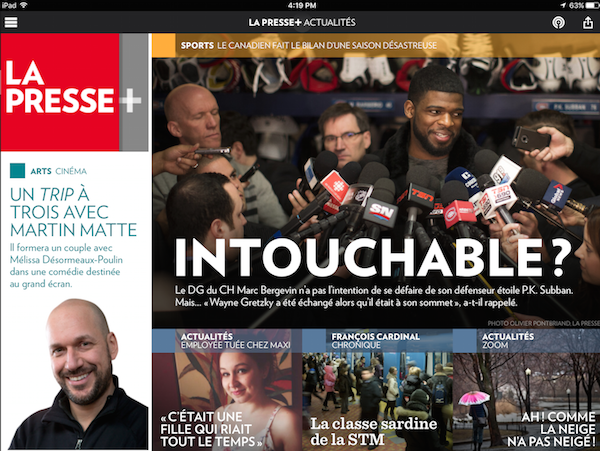Insights from CTV leaders at Dentsu, Horizon Media and more
Who said tablets are dead? Montreal daily La Presse’s betting its future on them

When La Presse, Montreal’s upscale French-language daily, went all digital on weekdays as of Jan. 1, it pushed readers to its free tablet app.
Three months of data later, La Presse is claiming success. About half the paper’s daily print readers transitioned to the app, execs believe. The paper managed to hold on to most of its ad revenue; first-quarter 2016 was down only slightly from the year-earlier, as some advertisers shifted dollars to the Saturday paper, the one remaining print edition. La Presse is privately owned by Gesca, a subsidiary of Power Corp. of Canada, and doesn’t release specifics, but executives there said operating income has improved.
The tablet app, La Presse+, was already established in the market, having launched in 2013, and executives didn’t know if there was still room for growth. Before January 1, the app was getting about 190,000 unique openings per day. Today, though, unique daily openings stand at 255,000. The paper believes a strong marketing push over the years had helped form a strong base of users: it spent about $8 million over three years, on broadcast, billboards and events to get the word out about its app.
While other publishers are obsessed with capturing smartphone readers, La Presse put a big bet on tablets, figuring it’s where the time and money are. Tablet penetration in Canada has increased to 55.6 percent from 42.8 percent the year the app launched in 2013, according to eMarketer. While smartphones are conducive to quick, on-the-run news catchups, tablets support a rich editorial experience designed for longer reading sessions (La Presse+ users average a print magazine-like 40 minutes per weekday and 60 minutes on Saturday).

Tablets also can command higher ad rates than the typical phone app and desktop site can. La Presse+ claims to charge a $51 CPM, practically unheard of on phone app and desktop site; the app now supplies 75 percent of the paper’s total ad revenue. La Presse has a website and smartphone app, too (Lapresse.ca has 2.5 million monthly unique visitors) but they serve to breaking news and push people to the app.
“What mattered to us was, we have a huge installed base, and it reached 25- to 54-year-olds,” Levasseur said. “And tablet lets you create a highly engaging experience. You’re able to charge a CPM that’s in line with that. I have not found one group in the world that has managed find a business model that makes sense on a mobile phone. Yes, there’s eyeballs, but they’re eyeballs at a $1 CPM.”
In designing its app, La Presse+ had to give readers a reason to stick around. The result is an edition that’s refreshed once a day, like a daily newspaper; it’s not for people who are looking for breaking news. Stories are richly told, with interactive maps, photos and videos. It’s free, to make it more attractive to the young readers La Presse is after. The newsroom produces for tablet-first, then thinks about what elements could work in the Saturday print edition.
To justify charging a high CPM and avoid turning off readers, the La Presse+ sought to make ads that would become part of the reading experience. La Presse+’s ads are highly interactive, with 26 types of interactions that advertisers can pick from. To remove barriers for advertisers (who have to make bespoke ads just for the app), La Presse created a $100 kit that lets advertisers build ads quickly and cheaply by repurposing their existing assets.

Levasseur said key to the app’s success was to treat it as one that would replace the print product, and not just another platform. Designing the app, which was three years in the making, was an exercise in technology. There was particular attention to speed; to reduce the app’s load time, it developed tech that lets ads load in stages and loads sections based on the reader’s browsing behavior. (The app was developed by Nuglif, a company that’s now a subsidiary of La Presse) “Speed was very important because the user experience was at the core of everything we did,” he said.
As other newspaper publishers stare down their own bleak print futures, the big question is to what extent La Presse’s experience can offer a sustainable model for digital news. Kirk Allen, co-founder and COO of Reshift Media, a Toronto-based digital marketing company, and a vet of the English-language Montreal Gazette, said La Presse will have to convince advertisers that the readers are still using its app and that they’re providing the same value the printed version did, a challenge that would apply to other newspapers. “I don’t think the advertiser views the digital impression as the same as a tangible print one,” he said.
Then there’s the question of what will happen to tablet use as smartphone penetration grows. Levasseur believes tablets are here to stay for a long time, but conceded that if that changes, “we have to be as agile as we have been on whatever platform going forward.”
Image courtesy of Emmanuel Huybrechts/Wikimedia Commons.
More in Media

Digiday+ Research: Publishers pull back their dependence on digital revenue
After a year in which publishers shifted their revenue dependence away from traditional channels and toward digital channels, 2025 has seen a shift back toward more of a balance between traditional and digital revenue sources.

LinkedIn makes it easier for creators to track performance across platforms
Creator data is becoming more accessible to third-party vendors via a new API — another step in LinkedIn’s creator platform evolution.

Ad Tech Briefing: The ‘plumbers’ posing as the unlikely saviors of the internet
After several false dawns, can Cloudflare’s ‘anti-AI scraping tool’ finally offer publishers a road to commercial redemption?





